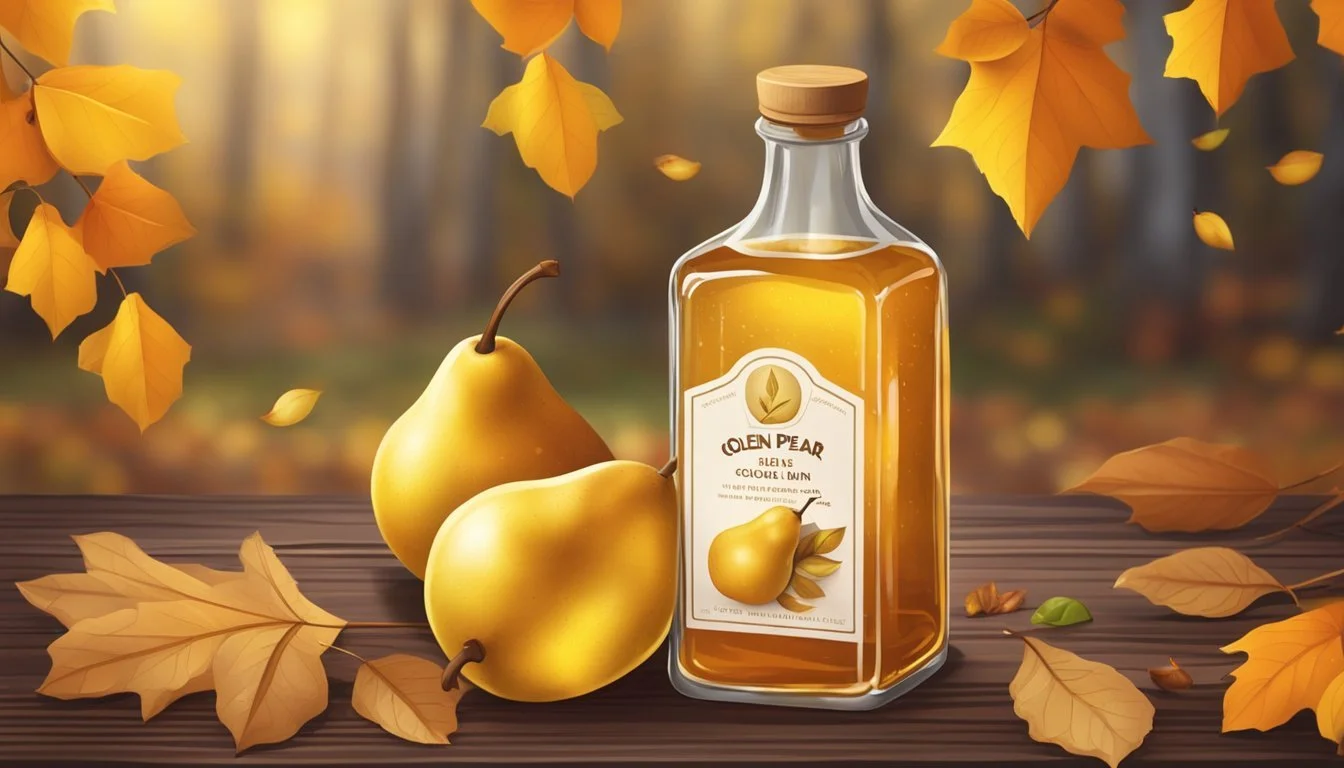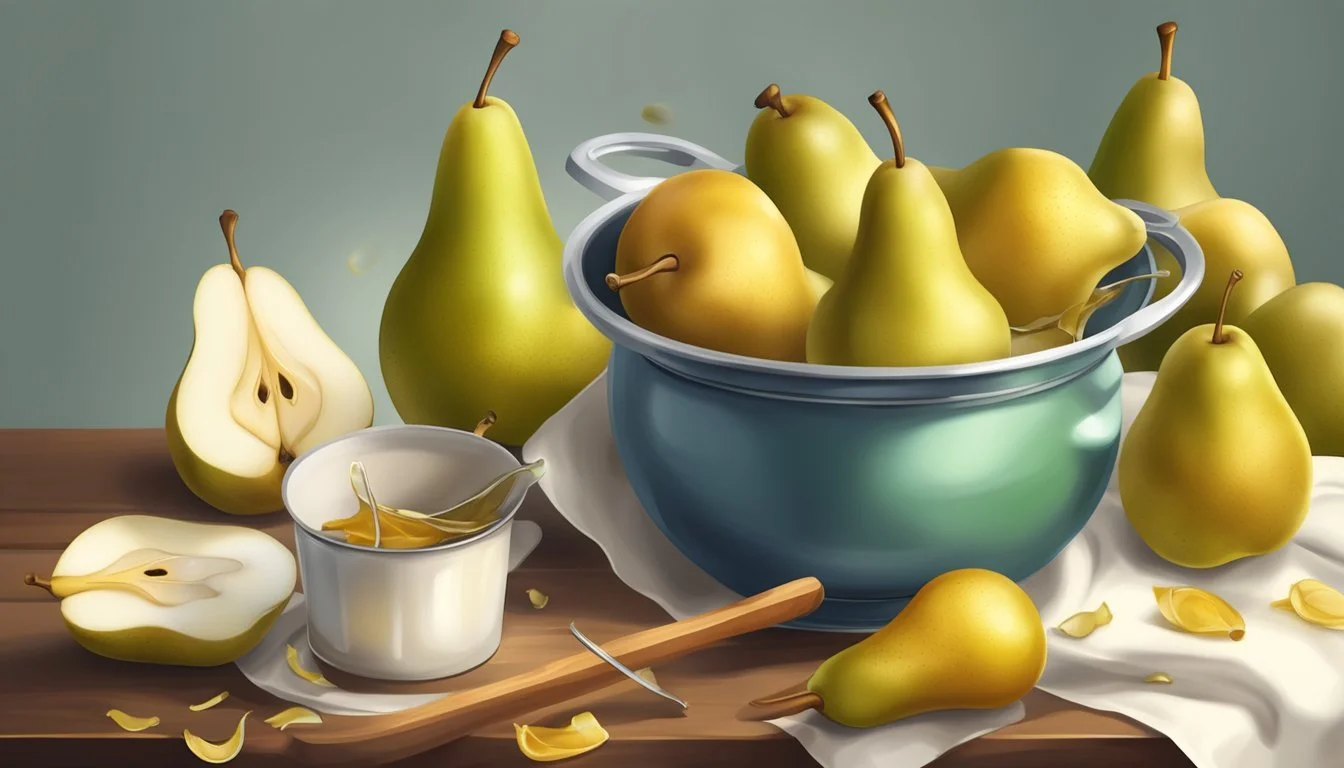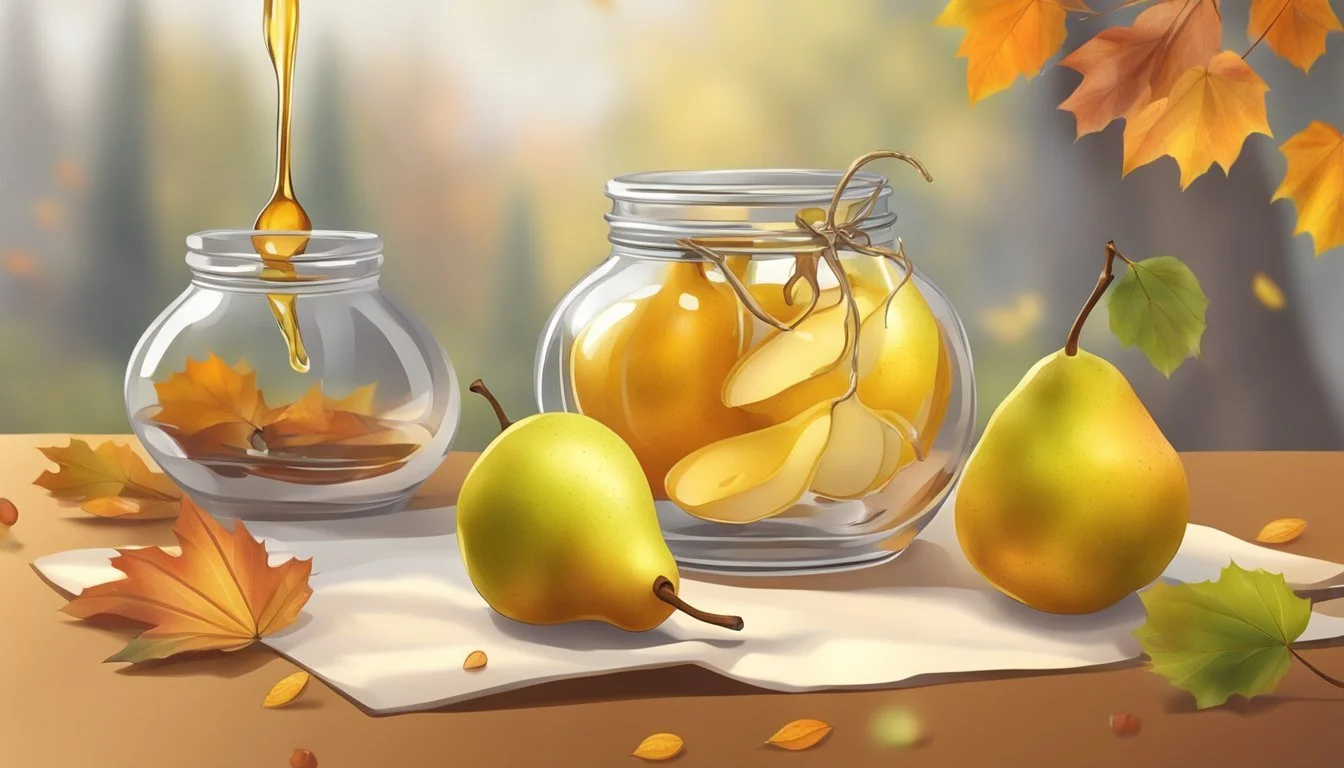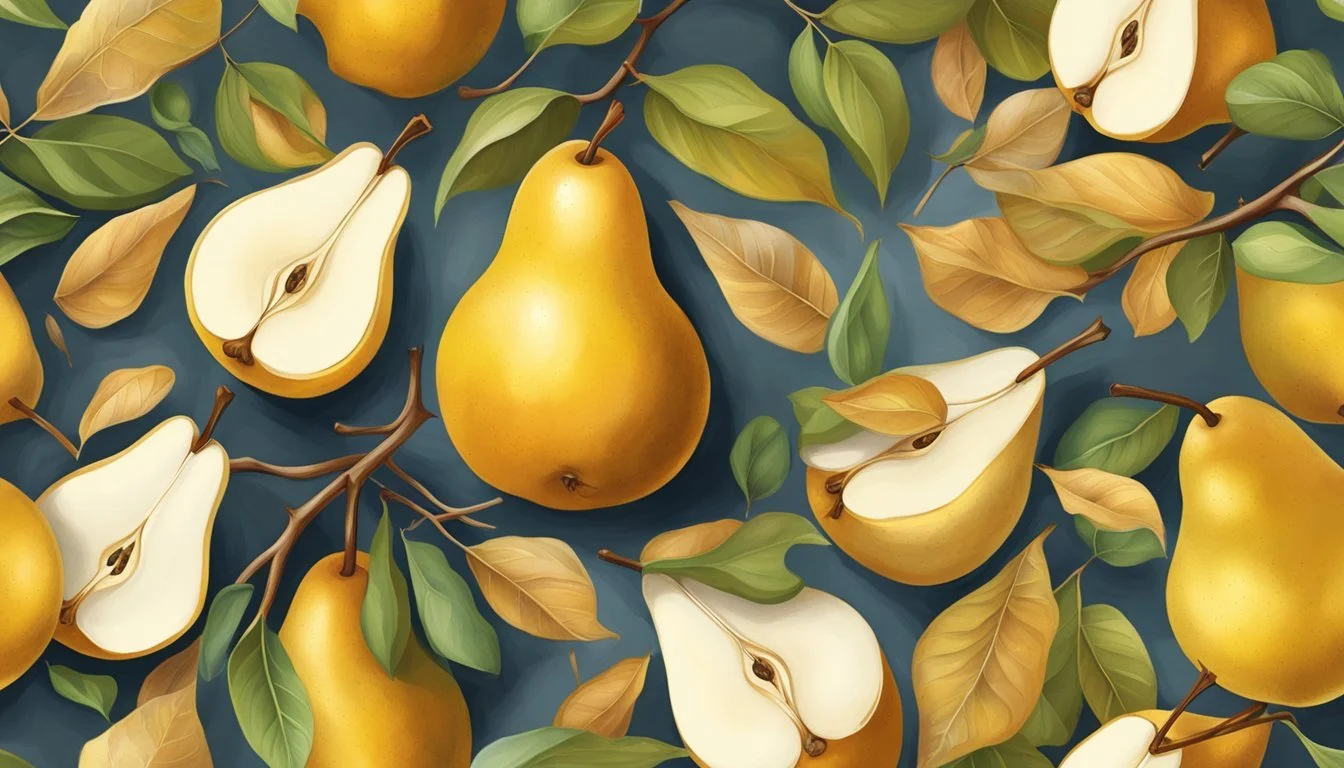Pear Peel Syrup
A Fragrant, Autumnal Sweetener for Seasonal Recipes
Pear simple syrup is a fragrant sweetener that captures the essence of autumn in a bottle. This delectable syrup combines the sweetness of ripe pears with the simplicity of a classic simple syrup, infusing drinks and desserts with a subtle, mellow fruitiness that complements the season's flavors. Gaining popularity among culinary enthusiasts, pear simple syrup offers a twist on traditional flavorings and introduces a versatile ingredient to the pantry.
The beauty of pear simple syrup lies in its simplicity. With just three core ingredients—pear, sugar, and water—it is easily crafted at home without the need for complicated equipment or techniques. The natural juices from the pears infuse the syrup with a unique flavor profile, which ranges from sweet to slightly floral, depending on the pear variety used. This allows for a wide range of applications, from enhancing cocktails and teas to sweetening baked goods and drizzling over breakfast dishes.
Tailoring the concentration of flavors to personal preference, one can adjust the ratio of fruit to sweetener or experiment with additional spices such as cinnamon or vanilla. The production of pear simple syrup involves simmering these ingredients together until the natural sugars in the pears meld harmoniously with the syrup, creating a preserve that not only sweetens but also elevates the taste experience of any culinary creation it graces.
Essential Ingredients for Pear Peel Syrup
Crafting pear peel syrup requires a thoughtful selection of ingredients to ensure a balance of sweetness and flavor. This section will guide the reader through the best choices for pears, sweeteners, and flavor enhancers.
Selecting the Best Pears
Choosing the right type of pear is crucial for a quality syrup. One should look for pears that are ripe and aromatic, as they will impart a more intense flavor. Bosc and Anjou pears are excellent choices for syrups due to their rich taste and balanced sweetness.
Choosing Your Sweeteners
Sweeteners are the backbone of any syrup. The ideal choice for pear peel syrup is granulated sugar, as it dissolves easily and provides a clear, sweet base without altering the natural pear flavor. For every cup of water, one typically uses one cup of granulated sugar.
Water: 1 cup
Granulated Sugar: 1 cup
Additional Flavor Enhancers
To enrich the syrup, additional flavor enhancers can be added. A stick of cinnamon or a teaspoon of vanilla extract will complement the pear's natural flavors without overpowering them. These should be added during the simmering process and removed before storage.
Flavor Enhancers:
Cinnamon: 1 stick
Vanilla Extract: 1 teaspoon
Pear Peel Syrup Preparation Techniques
In crafting pear peel syrup, meticulous attention to the simmering, straining, and boiling processes ensures a high-quality end product. Storage technique is also pivotal for maintaining the syrup's shelf life and flavor integrity.
The Process of Simmering Pear Peels
To extract the maximum amount of flavor, one simply simmers the pear peels in water. This is done by placing pear peels in a saucepan, covering them with water, and applying medium heat. The mixture should be periodically stirred and allowed to simmer gently for about 30 minutes to ensure the peels' aromatic essence infuses into the liquid.
Straining to Achieve Clarity and Purity
After simmering, the pear-infused liquid must be separated from the solid peels to achieve a clear syrup. Using a fine mesh sieve, one strains the mixture to remove the peels and any other impurities. For a smoother syrup, a cheesecloth can be used in conjunction to further refine the consistency.
Boiling and Dissolving Sugar
The next step involves adding sugar to the pear-infused water. The syrup's sweetness is calibrated by boiling the mixture and dissolving the sugar completely. It is crucial to constantly stir while the mixture boils to prevent burning and to ensure an even consistency throughout the syrup.
Cooling and Storing Syrup Correctly
Once the sugar is fully dissolved and the syrup has formed, it needs to be removed from the heat and allowed to cool. Proper storage is critical for preserving the syrup's quality; it should be transferred to an airtight container, such as a mason jar, and stored in the refrigerator. This helps in maintaining both the syrup's flavors and its shelf life.
Culinary Applications for Pear Syrup
Pear syrup adds a fragrant sweetness to a variety of culinary creations, from enhancing the simple pleasures of desserts to adding a nuanced flavor to savory dishes.
Enhancing Sweet Treats and Desserts
Ice Cream: A drizzle of pear syrup over vanilla or cinnamon ice cream brings an autumnal twist to this classic dessert.
Pancakes and Waffles: Incorporating pear syrup into the batter or using it as a topping adds a fruity depth to breakfast favorites.
Cocktail and Mocktail Creations
Cocktails: Mixologists can substitute traditional sweeteners with pear syrup to introduce complex flavors to cocktails.
Mocktails: For alcohol-free options, pear syrup provides sweetness and aroma to drinks like sparkling water with a squeeze of lemon.
Hot Tea: Adding a spoonful of pear syrup to hot tea creates a cozy and soothing beverage, perfect for chilly evenings.
Creative Uses in Main Courses and Salads
Pork and Chicken: As a glaze, pear syrup caramelizes nicely on proteins such as pork and chicken, offering a delicate balance of sweetness.
Salad Dressings: Whisked into vinaigrettes, pear syrup can transform a simple salad with its unique taste and hint of fruitiness.
Pairing Pear Syrup with Other Flavors
Pear syrup's subtle sweetness and aromatic quality make it a versatile ingredient that enhances a variety of flavors. Expertly pairing it with the right components can elevate any culinary creation.
Spice Combinations for Complexity
Pairing pear syrup with spices can introduce a warm complexity to desserts and beverages.
Ginger: A classic pairing, ginger brings a peppery heat that contrasts delightfully with pear syrup's mellow sweetness.
Cinnamon and Clove: These spices provide an autumnal warmth that complements the fruit's cozy notes.
Complementing Fruits for Layered Tastes
Combining pear syrup with other fruits can create intricate, multi-tiered flavor profiles.
Peach: Pear and peach syrups can be combined to craft a sweet, stone fruit-flavored nectar for cocktails or sodas.
Cranberry: Pear syrup blended with cranberry juice yields a tart yet sweet concoction, perfect for holiday drinks.
Tables or drinks featuring these combinations draw out the fruity flavor in both the pear syrup and its fruity counterparts, allowing for a richer taste experience.
Herbs, Citrus, and Other Delicate Notes
Pear syrup's delicate profile is wonderfully complemented by various herbs and citrus notes, making it a flexible choice for creative mixologists and chefs.
Rosemary: Introducing rosemary to pear syrup can infuse it with a piney aroma, ideal for savory dishes or robust cocktails.
Lavender: For a fragrant twist, lavender pairs seamlessly with pear syrup, offering floral notes that are splendid in iced teas or desserts.
Citrus: A touch of lime juice or a splash of lemonade mixed with pear syrup creates a refreshing, tangy contrast that's perfect for summer sips.
Utilizing these combinations provides layers of flavor that are complex yet harmonious, enhancing the overall profile of the pear syrup.
Nutritional Information and Dietary Considerations
Pear peel syrup is a unique sweetener that provides a distinct flavor and various nutritional components. This section delves into the specifics of its caloric content, carbohydrate and fiber makeup, and dietary considerations for individuals with specific restrictions or allergies.
Caloric and Sugary Attributes
Pear peel syrup, akin to other sweeteners, is primarily composed of sugars which contribute to its caloric value. A tablespoon of pear peel syrup may contain around 52 calories. The sweetener's calorie content is crucial for those monitoring their energy intake.
Understanding Carbohydrates and Fiber Content
The majority of the calories in pear peel syrup are derived from carbohydrates, mostly in the form of sugars. Unlike whole pears, the syrup's fiber content is significantly reduced due to the removal of the fruit's flesh and skin during processing. However, trace amounts of fiber may still be present if the syrup is less refined.
Allergens and Dietary Restrictions
Allergens in pear peel syrup are rare, making it suitable for most diets. It is naturally free of fat, saturated fat, unsaturated fat, and sodium, making it a safe choice for individuals with dietary restrictions related to these nutrients. The syrup has negligible amounts of protein. Those with sugar sensitivities or diabetes should use pear peel syrup cautiously due to its sugar content.
Preservation and Storage Tips for Pear Syrup
Proper storage techniques are essential for maintaining the quality and extending the lifespan of pear syrup. By adhering to optimal refrigeration practices and understanding the best methods for freezing and tracking shelf life, one ensures the syrup retains its fragrant, autumnal sweetness for future use.
Optimal Refrigeration Practices
Once pear syrup is cooled, it should be transferred to an airtight container to prevent exposure to air, which can diminish its quality. It is recommended to store this container in the fridge, where the chilly temperature slows down the degradation process. Keeping pear syrup refrigerated can maintain its freshness best for immediate to medium-term use.
Freezing for Long-Term Use
For those who wish to preserve pear syrup for several months, freezing is an effective method. Pour the syrup into an airtight container, leaving some space at the top, as liquids expand when frozen. Alternatively, one can pour the syrup into ice cube trays to freeze, creating conveniently sized portions for later use. Once completely frozen, transfer the cubes to a freezer bag or container to prevent freezer burn.
Shelf Life and Best Before Dates
Stored in the fridge, pear syrup usually maintains its quality for up to a month. When frozen, it can last between eight to ten months. It is essential to label the storage container with the date of creation to track how long it has been stored. Syrup stored at room temperature should be kept in a cool, dark place and ideally used within a couple of weeks, as it is more susceptible to spoilage. Always inspect the syrup before use; if it shows any signs of spoilage or has a noticeable off-smell, it should not be drizzled over dishes.
Creative Recipes and Serving Suggestions
Pear peel syrup infuses a unique fragrant sweetness into a variety of dishes, enhancing flavors with its subtle autumnal notes. Whether incorporated into morning delicacies or transformed into dressings, glazes, and refreshing beverages, its versatility elevates the culinary experience.
Pear Syrup in Baked Goods and Breakfasts
Baked Goods:
When adding pear peel syrup to cakes, replace part of the liquid sweetener in the recipe. It imparts a moist texture and a nuanced flavor.
Prep Time: Varies based on the recipe
Cook Time: As per recipe instructions
Breakfast Items:
Drizzle pear syrup over oatmeal or yogurt for a natural sweetener that provides an aromatic twist sans artificial flavors.
Quick and effortless, simply integrate the syrup during or after preparation.
Handcrafted Dressings and Glazes
Salad Dressings:
Create exquisite salad dressings by emulsifying pear peel syrup with quality oils and vinegars. Adjust portions to taste:
Whisk together for a balanced, sweet-tangy profile, enhancing any salad.
Glazes:
Incorporate the syrup as a glaze for roasted meats or vegetables:
Prep Time: Approximately 5 minutes
Cook Time: Brush on in the last minutes of roasting for a caramelized finish.
Beverage Innovation with Pear Syrup
Tea and Coffee:
Sweeten tea or coffee by stirring in pear syrup to replace traditional sweeteners, yielding a comforting beverage especially delightful in cold weather.
Prep Time: Instant – mix in as desired.
Crafted Coolers:
For a refreshing twist on standard drinks, blend pear syrup into iced tea or craft unique mocktails:
Combine with other ingredients and serve chilled, emphasizing the syrup's delicate pear essence.
Advanced Pear Syrup Crafting Techniques
When crafting pear peel syrup, advanced techniques can be employed to develop a richer, more complex flavor profile. These methods not only intensify the inherent essence of ripe pears but can also infuse the syrup with nuanced undertones from a variety of spirits and liqueurs.
Reducing Syrups to Intensify Flavor
Reducing pear syrup is a method to concentrate the flavors and thicken the consistency. To do this effectively:
Begin with ripe pears: Fully ripe pears contribute more natural sugars, which caramelize and deepen in flavor during reduction.
Simmer slowly: Gentle heat allows for the evaporation of water without scorching the sugars. Monitoring the heat is crucial to avoiding burnt flavors.
Mash techniques: As the syrup simmers, mashing the pear peels intermittently can extract maximum flavor, ensuring that every ounce of fruity essence is captured.
Blending Syrups with Spirits and Liqueurs
Blending pear syrup with alcohol can add layers of complexity:
Select your spirits: Spirits like vodka and rum can imbue the syrup with a warming depth, while gin can introduce herbal notes.
Ratio balance: Maintaining an appropriate balance between the pear syrup and chosen spirit is key. A standard ratio is one part spirit to three parts syrup.
Infusion: For a more profound transformation, alcohol and syrup can be combined in a sealed container and left to infuse, wherein the flavors marry over time.
By applying these advanced crafting techniques, one can elevate the humble pear syrup into a sophisticated, artisanal condiment that resonates with both sweet and savory notes, ideal for culinary experimentation.
Troubleshooting Common Pear Syrup Challenges
Creating pear syrup involves careful attention to process and details. This section seeks to assist readers in navigating the challenges they may encounter during preparation and cooking to achieve the perfect consistency and flavor.
Avoiding Common Mistakes in Preparation
The initial steps set the stage for the quality of your pear syrup. Preparation is crucial. A common mistake is not properly washing and peeling the pears, which can introduce unwanted impurities into the syrup. Make sure to thoroughly cleanse the fruit, and consider peeling it if the peel is tough or blemished.
When measuring ingredients, precision is key. Miscalculations can lead to an imbalanced syrup, where the flavors are not properly extracted or the texture is off. Use measuring cups and follow the recipe exactly.
Ensuring Consistency and Desired Texture
Consistency in pear syrup arises from a controlled cooking method. When bringing ingredients to a boil, watch the pot closely. A rolling boil is too vigorous and may cause the pears to break down too quickly, while a simmer that's too low won't allow the flavors to extricate effectively.
As the syrup simmers, one must ensure the sugar fully dissolves. Stirring occasionally helps prevent the sugar from settling at the bottom and burning. If graininess persists, it indicates the need for additional cooking time, ensuring the mixture is evenly heated.
After the syrup has reached the desired thickness, strain it with a fine mesh strainer. This separates the solids from the liquid, resulting in a smooth, refined syrup. If solids pass through, your mesh might not be fine enough, or the syrup requires additional straining.
It is essential for cooks to pay close attention to both preparation and cooking phases, be patient, and adjust the heat as needed to ensure a high-quality pear syrup.
Professional Tips for Home Bartenders
Home bartenders can elevate their craft by integrating pear peel syrup into their drink repertoire, creating beverages with a sophisticated and autumnal twist.
Crafting Signature Cocktails with Pear Syrup
Utilizing pear syrup in cocktails affords a unique opportunity to impress guests with a custom drink menu. Here are some tips for crafting signature cocktails:
Seasonal Flavor Profile: A Bartlett pear's natural sweetness is complemented by autumnal spices. Infuse your pear syrup with cinnamon sticks, ginger, or rosemary to introduce depth and complexity.
Spirits Pairing: Pear syrup pairs exceptionally well with a variety of spirits. For a light and refreshing cocktail, they can combine it with gin. For a richer and warming drink, rum or vodka serve as excellent bases.
Example Cocktail Recipe:
Ingredients Quantity Instructions Pear Syrup with Rosemary 1 oz Add to shaker Gin 2 oz Combine with pear syrup Fresh Lemon Juice 0.5 oz Add to mixture Ice As needed Fill shaker Rosemary Sprig For garnish Shake well and strain, garnish to serve
Mocktail Masterpieces
Mocktails deserve the same level of attention and creativity as their alcoholic counterparts. Pear syrup brings a refined taste to non-alcoholic beverages that can rival any cocktail:
Complementary Flavors: Enhance pear syrup with non-alcoholic elements like sparkling water or tea to create a refreshing mocktail. Ingredients like ginger add a spicy kick, which complements the syrup’s sweetness.
Example Mocktail Recipe:
Ingredients Quantity Instructions Pear Syrup infused with Ginger 1 oz Pour into glass Sparkling Water to top Add over pear syrup Lime Wedge 1 Squeeze in lime, drop wedge into glass Ice As needed Stir gently, serve immediately
By infusing their simple syrup with pear peels and complementary spices, home bartenders can offer exceptional, flavor-rich cocktails and mocktails that showcase their skills and creativity.
Seasonal Inspirations for Pear Syrup
Pear syrup captures the essence of the fruit's delicate flavor, making it a versatile ingredient that can be infused with a range of seasonal spices and herbs to complement various times of the year.
Fall Flavors and Holiday Specials
In autumn, pear syrup is elevated with the warm, spicy notes of cinnamon and cloves, embodying the comfort of the season. It serves as an exceptional base for holiday drinks, enhancing them with a festive, fruity sweetness. Integrating thyme can add a sophisticated and earthy aroma, suitable for sophisticated fall themed dinners.
Cinnamon: Adds a sweet and woody flavor, perfect for fall-inspired desserts and lattes.
Cloves: Imparts a bold, pungent taste, ideal for spiced cocktails or ciders.
Thyme: Offers a subtle, savory undertone, excellent when drizzled over roasted vegetables or pork.
Autumn recipes frequently feature pear syrup mixed with cranberry for a tart contrast or blended with maple syrup to enrich its complexity. This symphony of flavors is not only delightful to the palate but also encapsulates the heart of the season.
Summer Refreshers and Spring Twists
Transitioning into spring and summer, pear syrup adapts to the brightness of these seasons. Infused with lavender, it provides a floral note to lemonades and iced teas, making for a refreshing beverage on a warm day.
Lavender: Offers a light, floral touch that pairs well with the sweetness of pear.
Meanwhile, incorporating thyme brings a hint of herbaceous freshness to the syrup, making it a unique addition to spritzers and summer cocktails. The final product is a perfect companion for seasonal fruits or as a glaze for lighter dishes such as grilled fish or chicken.
Thyme: Its minty and slightly lemony flavor complements the pear syrup in chilled summer beverages.
The adaptability of pear syrup with its affinity for seasonal ingredients makes it an ideal sweetener that can elevate dishes and drinks throughout the year.
Packaging and Presenting Pear Syrup
When bottling pear syrup, one must consider both aesthetics and functionality to ensure the product's longevity and appeal. Proper packaging seals in the syrup’s aroma and flavor, while an attractive presentation adds to its allure as a homemade or commercial product.
Decorative Bottling and Labeling
For homemade pear simple syrup, mason jars are a popular choice due to their rustic charm and reliable seal. A key to freshness is ensuring that the syrup is stored in an airtight container, and mason jars offer this along with the ability to see the rich hue of the syrup. Adding a custom label with the name, ingredients, and date of production helps in identification and adds a personal touch. Labels might include calligraphy or a pear-themed motif to evoke the syrup's natural origins.
Suggested Labeling Details:
Product Name: Homemade Pear Simple Syrup
Date of Production
Ingredients
Storage Instructions
Gift Ideas and Commercial Packaging
Pear syrup makes an excellent gift or commercial product, especially when thoughtfully packaged. Incorporating elements of the syrup’s autumnal theme can captivate one's sense of seasonality. When packaging for commercial sale or as gifts, canned pears in the syrup can augment its visual appeal and texture. The inclusion of pear pieces signals a commitment to natural ingredients and homemade quality. If gift-wrapping, consider earth-toned ribbons or twine, and attach serving suggestions or cocktail recipes to entice and inspire the receiver.
Commercial Packaging Tips:
Sturdy bottles with secure lids for transport
Clear glass to showcase the product
Branding that tells the syrup's story or origin










